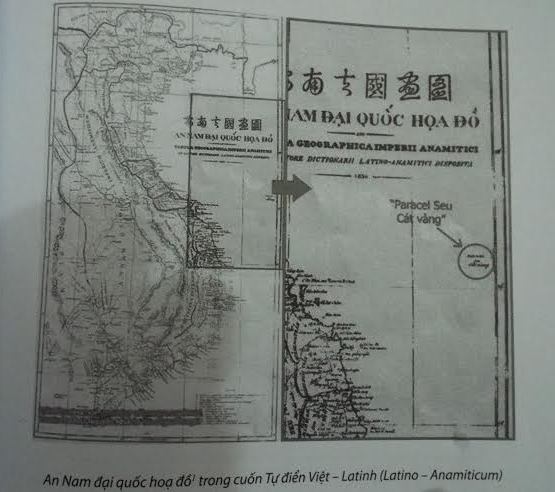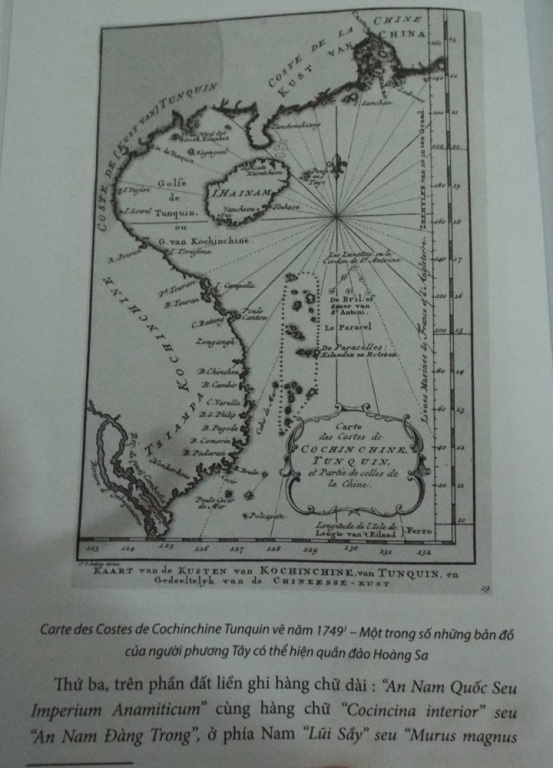|
Ancient records show
Vietnam’s sovereignty over Hoang Sa - Truong Sa
VietNamNet would like to introduce a
series of articles on ancient documents proving Vietnam’s sovereignty over
the archipelagos of Hoang Sa (Paracel) and Truong Sa (Spratly).
The earliest records
The map of An Nam by French priest Jean-Louis
Taberd.
Hoang Sa was called by westerners as “Paracels” in the
19th century. Documents by Western researchers, missionaries and merchants all
described Paracels as a series of islands, rocks and coral reefs along the
central coast of
Until the 18th century and a long time after that,
Vietnamese geographers and the western navigators did not distinguish Paracel
as the two archipelagos of Hoang Sa and Truong Sa as today.
For Vietnamese people, the name Hoang Sa, Bai Cat Vang,
Dai Truong Sa or Van Ly Truong Sa referred to the islands stretching from the
north to south
Doctor of history Nguyen Nha and his European
colleagues have discovered a very interesting detail: The Chinese in ancient
and medieval ages were not interested in the sea. For them, the territory was
called "江山" or "mountains and rivers", understood
in the modern language as the mainland.
For the Vietnamese, territory had a broader sense, as
“dat nuoc” (water and land) in Vietnamese. In the minds of the Vietnamese
people, "dat nuoc" is a country including the mainland and islands.
However, the French were the first who distinguished
the two archipelagos by two different names. The French’s historic documents
show that Paracels or Hoang Sa is in the north and Spratley is in the south.
By the 1970s, the names of the two archipelagos were
used uniformly and popularly.
In general, though the names are different, but in the
ancient documents of Vietnam like “Dai Nam Thong Nhat Toan Do" (大南ー統全)(The Map of
United Dai Nam), which was compiled in the Nguyen Dynasty in 1838 and “Bac Ky
Hoi Do” (maps of the northern Vietnam), Hoang Sa and Truong Sa were drawn as
a series of islands from north to south.
Hoang Sa - Truong Sa in feudal
history

The map published in 1749 by western navigators
(Carte des Costes de Cochinchine Tunquin) , with Hoang Sa as
To date, the oldest document that provides the most
detailed description of Hoang Sa is the book “Phu Bien Tap Luc”
(Miscellaneous Chronicles of the Pacified Frontier, 1776) by well-known
Vietnamese historian Le Quy Don. This is a six-volume Chinese-language
geography. It is a detailed description of the Nguyen dynasty's territories
in Thuan Hoa and
Page 78 b and 79 a read as follows: “An Vinh Commune,
Binh Son District,
“… Bình Son District of Quang Ngai Prefecture includes
the coastal commune of An Vinh. Offshore to the northeast of An Vinh are many
islands and approximately 130 mountains separated by waters which can take
from few watches to few days to travel across. Streams of fresh water can be
found on these mountains. Within the islands is a 30-li long, flat and wide
golden sand bank, on which the water is so transparent that one can see
through. The islands have many swift nests and hundreds or thousands of other
kinds of birds; they alight around instead of avoiding humans. There are many
curios on the sandbank. Among the volutes are the Indian volutes. An Indian
volute here can be as big as a mat; on their ventral side are opaque beads,
different from pearls, and are as big as fingertips; their shells can be
carved to make identification badges or calcined to provide lime for house
construction. There are also conches that can be used for furniture inlay,
and
He also wrote: “Foreign boats often take refuge in
these islands to avoid storms. The Nguyen rulers have established Hoang Sa
Flotilla with 70 sailors selected from An Vinh commune on a rotation basis.
Selected sailors receive their order in the third month of every year, bring
with them sufficient food for six months, and sail on five small fishing
boats for three full days to reach the islands. Once settled down on the
islands, they are free to catch as many birds and fish as they like. They
collect goods from boats passing by, such as sabers, jewelries, money,
porcelain rings, and fur; they also collect plenty of sea turtle shells, sea
cucumbers, and volute shells. The sailors return to mainland in the eighth
month through Eo Seaport. On their return trip, they first sail to Phu Xuan
Citadel, where the goods that they have collected shall be submitted to be
measured and classified; they can then take their parts of volutes, sea
turtles, and sea cucumbers for their own trading businesses, and receive
licenses before going home. The amount of collected materials varies;
sometimes the sailors could not collect anything at all. I have personally checked
the notebook of the former flotilla captain Thuyen Duc Hau, which recorded
the amount of collected goods: 30 scoops of silver in the year of Nham Ngo
(1762), 5,100 catties of tin in the year of Giap Than (1764), 126 scoops of
silver in the year of At Dau (1765), a few sea turtle shells each year from
the year of Ky Suu (1769) to the year of Quy Ty (1773). There were also years
when only cubic tin, porcelain bowls, and two copper guns were collected.
The Nguyen rulers also established Bac Hai Flotilla
without a fixed number of sailors, selected from Tu Chinh Village in Binh
Thuan or from Canh Duong Commune. Sailors are selected on a voluntary basis.
Those who volunteer to join the flotilla will be exempted from poll tax,
patrol and transportation fees. These sailors travel in small fishing boats
to Bac Hai, Con Lon Island, and other islands in Ha Tien area, collecting
goods from ships, and sea products such as turtles, abalones, and sea
cucumbers. Bac Hai Flotilla is under the command of Hoang Sa Flotilla. The
collected items are mostly sea products and rarely include jewelries.”
Duy Chien
* The article
uses research materials by Dr. Han Nguyen Nguyen Nha, founder and advisor of
the Cultural Education Fund in
|
Thứ Năm, 12 tháng 6, 2014
Đăng ký:
Đăng Nhận xét (Atom)
Không có nhận xét nào:
Đăng nhận xét